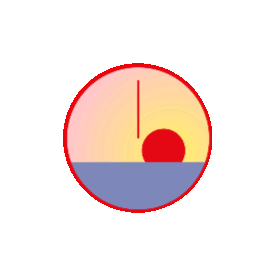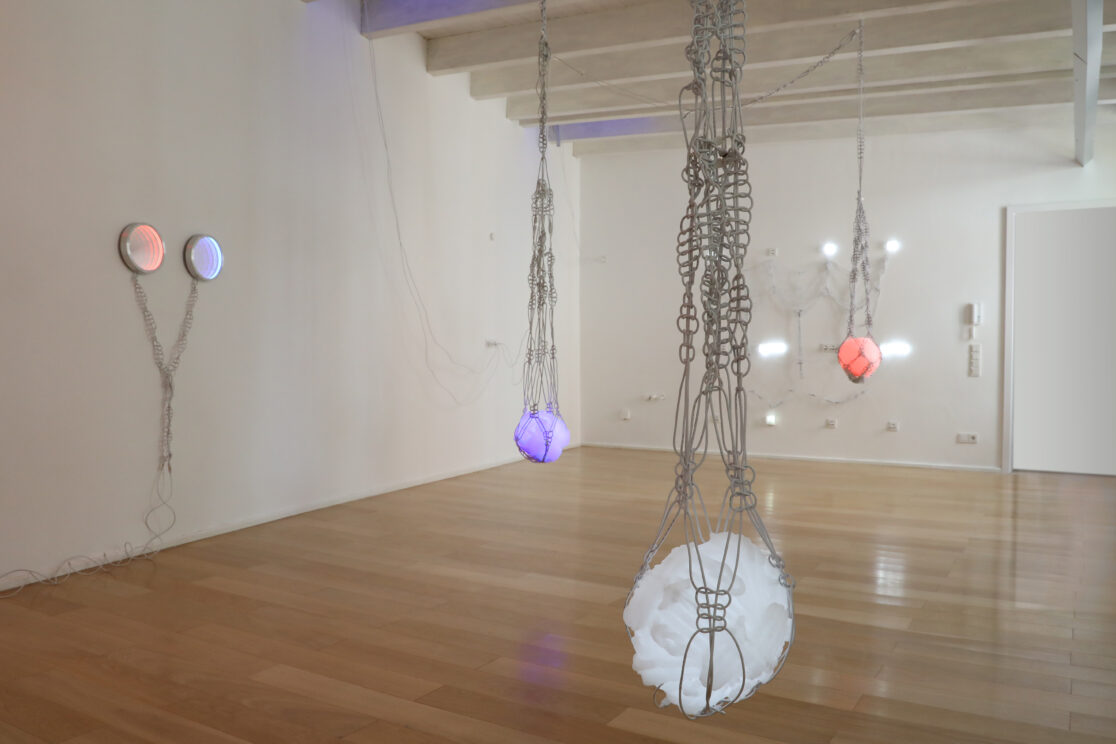Low Affintiy
Low Affinity is an installation of interconnected sculptures made from USB extension cords, USB splitters, plugs, paraffin wax, LEDs, zip ties, micro controllers and mini motors.
It makes use of every single of the spaces more than 20 outlets.
USB cables are the only cables that allow information and power to flow in both directions. But while the power always travels the information gets lost at a certain cable length—the longer the cable, the higher the entropy.
Knot making is an ancient craft to build structures, form containers and create decorative objects. It has always been used as a mnemonic technique to remember and pass on history; the knot tied in a handkerchief, cat‘s cradle games and tapestry, connect knot making, information, and power in a political sense.
Knotting together usb cables literally and conceptually creates structures of information and power, which form connections, contain, hold, and actually power the sculpted paraffin works which feature reliefs of hands and interwoven structures.
Today, information is the key concept drawn upon to frame and explain the universe—analogous to the ether in earlier times. The ether, one of the five classical elements, is a hypothetical substance which was imagined to either be a liquid or a solid and supposedly filled the universe to hold the stars in the sky and allow light to travel.
The liquid and solid states of paraffin lie close together, it melts at body temperature. The translucent material has another inherent relationship to light; for centuries it has been used to make candles. Holding shapes, paraffin wax can carry information—as a fingerprint, seal or sculpture. Because of its ability to change its state it references the idea of the ether and also reminds of Descartes’ wax argument which shows that there is an act of judgment involved in perception.
Deep association is a net-like structure of knotted USB extension cords, plugs, LEDs and small square paraffin sculptures which show partly surreal, partly realistic hands, switches, knots, and outlets. The site responsive piece was created for this space as it has an unusual number of outlets on this one wall. The piece is plugged into all of the outlets and is hold up by the plugs. The power travels through the whole knotted structure and lights the LEDs inside the paraffin sculptures.
False friends are two clocks, lit from the inside and connected to a timer. Both clocks have double sided mirrors in front of their mirrored faces. When the timer is on, the light inside the clocks is on: the double sided mirrors become transparent and create an infinity effect. When the timer is off, the mirrors are opaque and the viewer just sees their own reflection. The left clock is lit with red light, the right with blue light. I wrote the numbers on the face of the left clock with my left hand in counter clockwise direction. I wrote the numbers of the right clock with my right hand, in clockwise direction but mirrored the numbers. The left clock ticks clockwise, the right clock ticks counterclockwise. In the end both fail in displaying the time but 4 times a day, twice at 12 and 6. Both clocks are connected to each other and the timer with macramé style knotted usb extension cords.
The faces of the clocks are visible for 5:30 minutes (average time Europeans and US-Americans look at themselves in the mirror several times a day) and then just the mirror surface is visible for 27 seconds (average time museum visitors look at art works)
The duration of the present is a work to be installed in a room corner. The left part of the work shows a painted half clock face which, instead of numbers, has moon phases on it. The right part is a mirrored panel of the same size. The mirror completes the half clock face to a full circle with a full moon cycle on it. The clock has a second hand which ticks 3 seconds – from 58 to 59 to 60 (12 o’clock) and touches the mirror before it goes back to 58 in a quick sole movement.
Experiments have found that the time we experience as the present is 3 seconds long. Everything longer is already in the past or still in the future to come. The clock (like of course every other clock) is trapped in the present. We can see its past, the painted half clock face, but the hand can never reach the future, as it can’t go beyond the 12 and enter the mirror.
Low Affinity
(Magdalena Wisniowska, 2021)
The word ‘plane' conjures up an image of a brightly lit field, on which everything and anything may stands.The field in this image is squarish, with a mathematical axis, ‘x’ cutting one way, ‘y’ the other, and ‘z’ upwards and downwards, together mapping out a grid with each thing in its own little box. To make connections between things we draw (mostly) straight lines, from one point to another.
Deleuze and Guattari would argue that we have this image of the plane because of the link between ‘plane’ and ‘plan’. When we think of a plane this way, it acts as a hidden principle. We may not see the grid itself, but the grid is what makes things visible to us. It causes the given to be given by giving things their structure, organizing them, charting their development and growth. It is a plan(e) of organization and development, a genetic plan(e) of evolution. Because we do not see the principles by which it organizes things, only the result of its labors, the plane is transcendent to us and things, and likened to an idea in the mind of God.
For us the viewers, marked as we are by the ‘confirmation and selection bias’ and victim to the 'clustering illusion’ we look for these hidden principles finding patterns where there are none, making connections between things that are not in any way related. One such idea is central to the work Johanna Strobel shows at GiG Munich, the idea of aether, the fifth element of a classical world of four, in which everything can be divided into fire, earth, air and water. It was used to explain how stars stayed up in the sky, and moved across the heavens.
But there is another idea of a plane, in and on which there is no form or structure, only activity and its lack. This plane is populated by sub-atomic particles always in the process of transformation, but with no specific aim in mind. Depending on their activity, their speed and slowness, they compose assemblages, as Deleuze and Guattari write,‘ compositions of speed’. But they do not develop, organize according to a principle. They connect, disconnect, transform, reform. What happens, happens, in endless proliferation. Instead of development there is constant dissolution.
Johanna Strobel’s work conjures up both plan(e)s. There is a longing for principle, apparent in her systematic approach, plug going into socket, light being red or blue, going on or off. We can map this world quite easily on a grid. It is clean, white, metallic. There is also the understanding of a far more dissolute world in which entropy rules, of information lost through USB cables and mnemonic devices of knot-making failing. This world is unstable, reckless, and somehow also inexplicably present.























